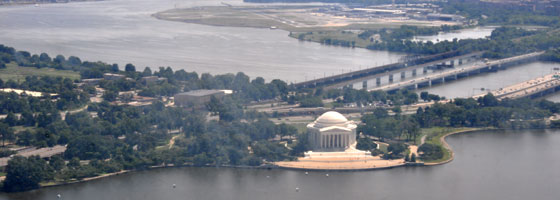Monitoring the nation’s rivers

Potomac River Basin
Terrorism events of the last decade have forced security officials to reconsider how to protect the nation’s infrastructure from sabotage, one of the key areas of concern being drinking water supplies. Of course, drinking water is not only vulnerable to terrorist attacks, but natural and unintentional contamination as well.
Homeland Security, the National Infrastructure Protection Plan, and the Bioterrorism Preparedness and Response Act of 2002 all identify water as a critical infrastructure that requires protection.
The urgency to defend this basic resource is perhaps greatest for the water that serves the nation’s capitol.
The Potomac River basin provides drinking water for millions in the Washington, DC area, including the water for the White House, Pentagon, Capitol Building, and the memorials and Smithsonian museums that surround the National Mall.
In order to protect this population from hazards in the water, the Metro Washington Council of Governments has implemented an extraordinarily sophisticated early warning system. The detection network includes real-time monitoring stations at several water intakes, treatment plants, high population areas, and critical buildings in the capital region.
NexSens Technology was consulted to provide a data logging and real-time telemetry solution for the network. Each of the 16 monitoring stations include a NexSens Ethernet data logger that continuously streams water quality data.
The system utilizes both chemical and aquatic bio-monitoring technology that can detect a wide spectrum of toxins and chemicals in the water.
The bio-monitoring systems involve assessing the level of stress in fish exposed to the source water. They measure electrical signals emitted from the fish to see if their ventilation or behavior indicates they’re reacting to a contaminant.
Thanks to these advanced monitoring systems and NexSens data logging technology, DC officials will be able to respond quickly to a drinking water crisis.
Detroit and St. Clair Rivers
On Super Bowl Sunday in 2004, about 42,000 gallons of two toxic solvents — methyl ethyl ketone and methyl isobutyl ketone — gushed into the St. Clair River, forcing the closure of intakes for water plants serving tens of thousands of people in the Detroit area.
Although this may have been the worst, it hasn’t been the only major spill to hit the St. Clair. Both the Detroit and St. Clair Rivers have been under increased scrutiny in recent years because of these spills, which has prompted the implementation of an early warning system intended to immediately recognize river contaminants and identify the origin.
NexSens Technology was chosen to provide data logging equipment, software, and web datacenter service at 13 water treatment intakes along the two rivers.
The real-time data allows water utility, local, county, and state personnel to monitor the river water quality and receive notifications of spills or contaminants that may enter the rivers.
At the 13 water treatment facilities, NexSens data loggers collect measurements from several water quality sensing instruments, including YSI 6600 V2 multi-parameter sondes, Turner Fluorometers, Inficon Hapsite GC/MS, and Hach TOC analyzers.
NexSens iChart software serves as the centralized project database for data received from these instruments, and each parameter will have an alarm notification to alert officials of a possible contamination.
The project also uses NexSens’ WQData Web datacenter service to provide a realtime interface for viewing river water data at each treatment facility and other project offices.
The Internet-based, password-protected datacenter allows officials to view data in tables, statistical summaries, and graphs. Moreover, a built-in website forum facilitates communication and information.
Susquehanna River Basin
Drilling for natural gas in the Marcellus shale formation poses a significant threat to the Susquehanna River basin. The shale’s sedimentary rock holds sizable natural gas reserves, and a recent boom in drilling has endangered local water quality.
A monitoring system for the Susquehanna River itself is already in place, but a more comprehensive network was called for after much scrutiny of the water affected by the drilling.
The Susquehanna River Basin Commission (SRBC) is installing 30 remote water quality monitoring stations in the northwestern part of the Susquehanna basin, including the border between Pennsylvania and New York. These stations form a network that will broadcast real-time water quality data from local rivers and streams.
NexSens Technology is providing the data logging and remote telemetry systems. Each water quality station includes a NexSens data logger with built-in cellular modem.
The water quality data collected includes water temperature, level, pH, conductivity, dissolved oxygen, and turbidity measurements. It may be viewed by officials, scientists, and the public to keep tabs on their local rivers and streams for threat of natural gas pollution as well as any other irregularities in the water.
Ohio River
The Ohio River Valley Water Sanitation Commission (ORSANCO) is upgrading its Organics Detection System (ODS) with a new communication network and data management system.
The commission is working with NexSens to replace existing ODS sites using 56K telephone modems with high-speed Ethernet and cellular telemetry data loggers at 13 locations along the Ohio River in addition to a site at the ORSANCO headquarters.
The new system will provide automated detection notifications, a water quality data website, and automated data screening using NexSens iChart software.
iChart provides alarm notifications and can automatically post data to the WQData Web-based datacenter. WQData features multilevel password protection, a public portal, near real-time data presentation, narrative postings, active data sourcing, and a project information sharing forum.
The Organics Detection System was established in 1978 to detect the presence of volatile organic compounds in the Ohio River valley basin. Since then, the system has detected volatile contaminants from numerous unreported spills and releases. These detections are reported by station operators to downstream utilities, state, and federal agencies.
For more information on NexSens monitoring systems, call 888.426.2151 or email info@nexsens.com.
Image credit: Panoramio





0 comments